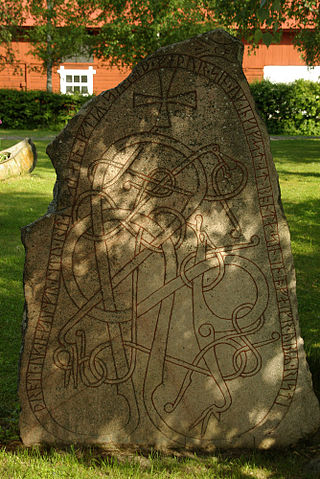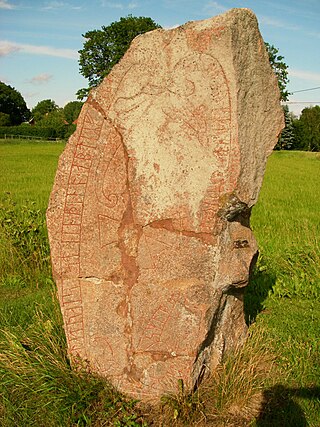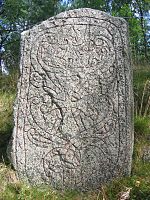The Funbo runestones constitute a group of four runestones originally from Funbo in the province of Uppland, Sweden, which were raised by members of the same family during the eleventh century.
The Runestones of Högby are runestones located in the village of Högby in Östergötland, Sweden, but the name Högby runestone usually refers to the notable Ög 81. It is famous for its eloquent epitaph in fornyrðislag for all the five sons of a man. The runestone was found when the church was demolished in 1874. Fragments of some other runestones were found as well. The Rundata project dates them to the late 10th century.

At Broby bro in Uppland, Sweden there are six runestones. U 139, U 140 and U 151 still stand by the road, but U 135, U 136 and U 137 have been moved a distance away from the road.

The Jarlabanke Runestones is the name of about 20 runestones written in Old Norse with the Younger Futhark rune script in the 11th century, in Uppland, Sweden.
The Ingvar runestones is the name of around 26 Varangian Runestones that were raised in commemoration of those who died in the Swedish Viking expedition to the Caspian Sea of Ingvar the Far-Travelled.

The Lingsberg Runestones are two 11th-century runestones, listed as U 240 and U 241 in the Rundata catalog, and one fragment, U 242, that are engraved in Old Norse using the younger futhark. They are at the Lingsberg farm about 2 kilometres (1.2 mi) east of Vallentuna, which is about 24 kilometres (15 mi) north of the center of Stockholm, Stockholm County, Sweden, which was part of the former province of Uppland.

The Hagby Runestones are four runestones that are raised on the courtyard of the farm Hagby in Uppland, Sweden. They are inscribed in Old Norse using the Younger Futhark and they date to the 11th century. Three of the runestones are raised in memory of Varangians who died somewhere in the East, probably in Kievan Rus'.
The Greece runestones are about 30 runestones containing information related to voyages made by Norsemen to the Byzantine Empire. They were made during the Viking Age until about 1100 and were engraved in the Old Norse language with Scandinavian runes. All the stones have been found in modern-day Sweden, the majority in Uppland and Södermanland. Most were inscribed in memory of members of the Varangian Guard who never returned home, but a few inscriptions mention men who returned with wealth, and a boulder in Ed was engraved on the orders of a former officer of the Guard.
The England runestones are a group of about 30 runestones in Scandinavia which refer to Viking Age voyages to England. They constitute one of the largest groups of runestones that mention voyages to other countries, and they are comparable in number only to the approximately 30 Greece Runestones and the 26 Ingvar Runestones, of which the latter refer to a Viking expedition to the Caspian Sea region. They were engraved in Old Norse with the Younger Futhark.

The Varangian Runestones are runestones in Scandinavia that mention voyages to the East or the Eastern route, or to more specific eastern locations such as Garðaríki in Eastern Europe.
The Viking runestones are runestones that mention Scandinavians who participated in Viking expeditions. This article treats the runestone that refer to people who took part in voyages abroad, in western Europe, and stones that mention men who were Viking warriors and/or died while travelling in the West. However, it is likely that all of them do not mention men who took part in pillaging. The inscriptions were all engraved in Old Norse with the Younger Futhark. The runestones are unevenly distributed in Scandinavia: Denmark has 250 runestones, Norway has 50 while Iceland has none. Sweden has as many as between 1,700 and 2,500 depending on definition. The Swedish district of Uppland has the highest concentration with as many as 1,196 inscriptions in stone, whereas Södermanland is second with 391.

The Tullstorp Runestone is a Viking Age memorial runestone, listed as DR 271 in the Rundata catalog, that is located in Tullstorp, which is about twenty kilometers east of Trelleborg, Skåne County, Sweden, and in the historic province of Scania.
The Baltic area runestones are Viking runestones in memory of men who took part in peaceful or warlike expeditions across the Baltic Sea, where Finland and the Baltic states are presently located.

Arkils tingstad is the remains of the Viking Age thing or assembly location of a hundred in Uppland, Sweden. It is situated on the outskirts of Stockholm. The remains consist of a rectangular stone formation and two runestones.

This runic inscription, designated as Sm 99 in the Rundata catalog, is on a Viking Age memorial runestone located in Nederby, which is about two kilometers northwest of Myresjö, Jönköping County, Sweden, and in the historic province of Småland.

The Fyrby Runestone, which is designated as Sö 56 in the Rundata catalog, is a Viking Age memorial runestone located in Fyrby, which is about 15 kilometers south of Flen, Södermanland County, Sweden, and in the historic province of Södermanland.

Uppland Runic Inscription Fv1946;258 or U Fv1946;258 is the Rundata catalog designation for a Viking Age memorial runic inscription to two fathers that is located in Fällbro, which is about 5 kilometers northwest of Täby, Stockholm County, Sweden, which is in the historic province of Uppland.

Uppland Runic Inscription 485 or U 485 is the Rundata catalog number for a Viking Age memorial runestone that is located in Marma, which is about six kilometers northeast of Knivsta, Uppsala County, Sweden, which was in the historic province of Uppland.

Uppland Runic Inscription 1145, or U 1145 in the Rundata catalog, is a Viking Age memorial runestone that is located near the town of Tierp in Uppland, Sweden.

The Vidbo Runestones are two Viking Age memorial runestones that are located in the churchyard of the Vidbo church, which is about 10 km (6.2 mi) east of Knivsta, Uppsala County, Sweden, in the historic province of Uppland.

























